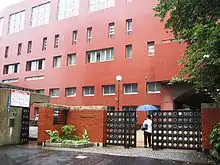Hibiya High School
Tokyo Metropolitan Hibiya High School (東京都立日比谷高等学校, Tōkyō Toritsu Hibiya Kōtōgakkō) is a Japanese high school founded in 1878 as the Tokyo First Middle School or Tokyo First Junior High School (東京府立第一中学校, Tōkyō Furitsu Daiichi Chūgakkō). It was well known in the 1950s and 1960s for the large proportion of graduates who gained admission to the prestigious University of Tokyo; though it suffered a decline in the 1970s, as of 2005 it was once again being referred to as the "best public high school in Japan".[2][3]
| Hibiya High School[1] | |
|---|---|
 | |
| Location | |

| |
Japan | |
| Information | |
| Type | Public |
| Established | 1878 |
| School district | Tokyo Metropolitan Government Board of Education |
| Principal | Naoomi Nagasawa (長澤直臣, Nagasawa Naoomi) |
| Website | http://www.hibiya-h.metro.tokyo.jp/ |
History
Tokyo First Middle School was established on 26 September 1878 in Tokyo's Hongō-ku; soon after, it moved to Kanda-ku, and moved several more times in the next two decades.[1] Its establishment was the result of the Meiji Restoration drive to modernise the model of education in order to catch up with Western Europe and the United States.The Meiji era government and Tokyo Imperial University requested the thickened as a part route to Tokyo Imperial University though Tokyo First did not lay weight at first on the side of going on to school.[4]
The school came to attract students not just from within Japan, but overseas as well; in 1904, out of 50 students granted scholarships by Korea's Joseon Dynasty for overseas study, 44 of them enrolled at Tokyo First Middle School. However, they were all expelled due to a protest they organised in 1905 over the signing of the Japan–Korea Treaty of 1905, which effectively made the Korean Empire a protectorate of the Empire of Japan. Later, they were permitted to re-enroll the following year. [5][2]

By 1918, only four decades after its foundation, Tokyo First had already become the first step on the "escalator course" which students expected would lead them to Tokyo Imperial University.[6] After World War II, Tokyo First Middle School went through a number of changes; it officially changed its name to Hibiya High School on 26 January 1950, and began admitting female students in April of the same year. Its first coeducational class enrolled 300 boys and 100 girls.[1]
Though First Tokyo's track record for getting its students into higher schools and universities in the pre-war period was beneath that of other elite middle schools (specifically Fourth Tokyo Middle School), between 1953 and 1967, Hibiya High School consistently ranked first in the number of graduates entering the top-ranked University of Tokyo, and due to its reputation for excellence, enrolled students from as far away as Kyūshū.[7] In common with the rest of the Tokyo public school system, its prestige declined during the early 1970s. Until 1976, at least 20 graduates were admitted to the University of Tokyo each year, down from the peak of 193 graduates in 1964, but according to one account, the school had "dropped out of the spotlight altogether".[3][7] In 1993, a single student from Hibiya High School gained admission to the University of Tokyo. However, under the leadership of the new principal Nagasawa, appointed in 2001, the school underwent a "renaissance". [8] In 2006, 12 students gained admission to the University of Tokyo, and two years later, that figure more than doubled to 28.[2][3]
Notable students and teachers
See also
References
- "日比谷高等学校". Hibiya High School. 2006. Retrieved 2007-04-11.
- Soh, Young-ah (2005-12-30). "Scholar Studies 1904 Student Expulsions". Donga Ilbo. Retrieved 2007-04-11.
- Gim, Hyeon-gi (2007-03-27). 平準化崩した校長の手腕…“日本版旧京畿高校”日比谷高が33年ぶりに復活 (in Japanese). JoongAng Ilbo. Retrieved 2007-04-11.
- 神辺靖光. 明治前期中学校形成史 府県別編I. 梓出版社. ISBN 978-4-87262-625-4. See pages Item of 東京府中学校.
- The leaders of the protest, including Choe Nam-seon (who would later become active in the 「Korean independence movement」), were permanently expelled. Later, except the leaders, other men returned to school, or changed schools.
- Reynolds, Jonathan M. (2001). Maekawa Kunio and the Emergence of Japanese Modernist Architecture. University of California Press. ISBN 0-520-21495-1. See page 41.
- Rohlen, Thomas P.; Björk, Christopher (2001). Education and Training in Japan. Routledge. ISBN 0-415-16842-2. See pages 20-22.
- In 2005, it was once again described by the Dong-a Ilbo, a South Korean newspaper, as "the best public school in Japan".
